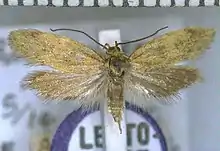| Tingena aphrontis | |
|---|---|
 | |
| Male lectotype | |
| Scientific classification | |
| Domain: | Eukaryota |
| Kingdom: | Animalia |
| Phylum: | Arthropoda |
| Class: | Insecta |
| Order: | Lepidoptera |
| Family: | Oecophoridae |
| Genus: | Tingena |
| Species: | T. aphrontis |
| Binomial name | |
| Tingena aphrontis | |
| Synonyms[2] | |
| |
Tingena aphrontis is a species of moth in the family Oecophoridae.[2] It is endemic to New Zealand and has been collected at altitudes between 3000 - 5000 ft at Arthur's Pass and Mount Arthur. The species lives in open alpine habitat amongst alpine vegetation. Adults of the species are on the wing in January.
Taxonomy
This species was described by Edward Meyrick in 1883 using specimens collected at Arthur's Pass at 5000 ft in January and named Cremnogenes aphrontis.[3] Meyrick gave a more detailed description under this name in 1884.[4] In 1915 Meyrick placed this species within the Borkhausenia genus.[5] George Hudson illustrated and discussed this species under the name B. aphrontis in his 1928 publication The butterflies and moths of New Zealand.[6] In 1988 J. S. Dugdale placed this species in the genus Tingena.[2] The male lectotype, collected at Arthur's Pass, is held at the Natural History Museum, London.[2]
Description
.jpg.webp)
Meyrick first described this species as follows:
Fore wings ochreous-yellow, partially suffused with grey, with a black discal dot ; hind wings dark grey, paler towards base.[3]
In 1884 Meyrick went into more detail, describing this species as follows:
Male, female. — 12-14+1⁄2 mm. Head and palpi ochreous-yellow, anterior edge of palpi suffusedly dark fuscous. Antennae blackish. Thorax dark fuscous, with yellowish lateral and posterior spots. Abdomen dark grey, posteriorly becoming whitish-ochreous. Legs dark grey, apex of joints obscurely ochreous-whitish, posterior tibiae with very dense ochreous-whitish hairs. Forewings moderate, costa moderately arched, apex round-pointed, hindmargin very obliquely rounded ; grey, more or less wholly suffused irregularly with ochreous yellow ; a blackish dot in disc beyond middle : cilia pale ochreous-yellow, somewhat mixed with grey. Hindwings grey, darker towards apex : cilia ochreous-whitish, suffused with dark grey towards base.[4]
This species is variable as the grey coloured patches are sometimes absent in some specimens.[6]
Distribution
It is endemic to New Zealand and has been collected at Mount Arthur and at Arthur's pass at altitudes of between 3000 - 5000 ft.[1][6]
Behaviour
This species is on the wing in January.[6]
Habitat
.jpg.webp)
This species lives in open alpine habitat amongst alpine vegetation such as grass and herbs.[4][6]
References
- 1 2 Gordon, Dennis P., ed. (2010). New Zealand inventory of biodiversity: Kingdom animalia: chaetognatha, ecdysozoa, ichnofossils. Vol. 2. p. 462. ISBN 978-1-877257-93-3. OCLC 973607714. OL 25288394M. Wikidata Q45922947.
- 1 2 3 4 John Stewart Dugdale (23 September 1988). "Lepidoptera - annotated catalogue, and keys to family-group taxa". Fauna of New Zealand. Department of Scientific and Industrial Research. 14: 99. doi:10.7931/J2/FNZ.14. ISSN 0111-5383. Wikidata Q45083134.
- 1 2 Edward Meyrick (September 1883). "Descriptions of New Zealand Micro-Lepidoptera.—III.—Oecophoridae". New Zealand Journal of Science. 1: 525. Wikidata Q106368126.
- 1 2 3 Edward Meyrick (1884). "Descriptions of New Zealand Microlepidoptera. III. Oecophoridae". Transactions and Proceedings of the New Zealand Institute. 16: 42. ISSN 1176-6158. Wikidata Q63976486.
- ↑ E. Meyrick (12 July 1915). "Revision of New Zealand Tineina". Transactions and Proceedings of the New Zealand Institute. 47: 213. ISSN 1176-6158. Wikidata Q63123349.
- 1 2 3 4 5 George Vernon Hudson (1928), The butterflies and moths of New Zealand, Illustrator: George Hudson, Wellington: Ferguson and Osborn Limited, p. 267, LCCN 88133764, OCLC 25449322, Wikidata Q58593286